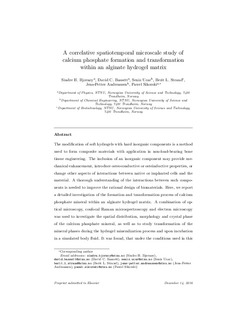| dc.contributor.author | Bassett, David | |
| dc.contributor.author | Ucar, Seniz | |
| dc.contributor.author | Sikorski, Pawel | |
| dc.contributor.author | Andreassen, Jens-Petter | |
| dc.contributor.author | Bjørnøy, Sindre Hove | |
| dc.contributor.author | Strand, Berit Løkensgard | |
| dc.date.accessioned | 2017-02-06T07:44:59Z | |
| dc.date.available | 2017-02-06T07:44:59Z | |
| dc.date.created | 2016-09-15T15:15:41Z | |
| dc.date.issued | 2016 | |
| dc.identifier.citation | Acta Biomaterialia. 2016, 44 254-266. | nb_NO |
| dc.identifier.issn | 1742-7061 | |
| dc.identifier.uri | http://hdl.handle.net/11250/2429526 | |
| dc.description.abstract | The modification of soft hydrogels with hard inorganic components is a method used to form composite materials with application in non-load-bearing bone tissue engineering. The inclusion of an inorganic component may provide mechanical enhancement, introduce osteoconductive or osteoinductive properties, or change other aspects of interactions between native or implanted cells and the material. A thorough understanding of the interactions between such components is needed to improve the rational design of such biomaterials. To achieve this goal, model systems which could allow study of the formation and transformation of mineral phases within a hydrogel network with a range of experimental methods and high spatial and time resolution are needed. Here, we report a detailed investigation of the formation and transformation process of calcium phosphate mineral within an alginate hydrogel matrix. A combination of optical microscopy, confocal Raman microspectroscopy and electron microscopy was used to investigate the spatial distribution, morphology and crystal phase of the calcium phosphate mineral, as well as to study transformation of the mineral phases during the hydrogel mineralization process and upon incubation in a simulated body fluid. It was found, that under the conditions used in this work, mineral initially formed as a metastable amorphous calcium phosphate phase (ACP). The ACP particles had a distinctive spherical morphology and transformed within minutes into brushite in the presence of brushite seed crystals or into octacalcium phosphate, when no seeds were present in the hydrogel matrix. Incubation of brushite–alginate composites in simulated body fluid resulted in formation of hydroxyapatite. The characterization strategy presented here allows for non-destructive, in situ observation of mineralization processes in optically transparent hydrogels with little to no sample preparation. | nb_NO |
| dc.language.iso | eng | nb_NO |
| dc.publisher | Elsevier | nb_NO |
| dc.rights | Attribution-NonCommercial-NoDerivatives 4.0 Internasjonal | * |
| dc.rights.uri | http://creativecommons.org/licenses/by-nc-nd/4.0/deed.no | * |
| dc.title | A correlative spatiotemporal microscale study of calcium phosphate formation and transformation within an alginate hydrogel matrix. | nb_NO |
| dc.type | Journal article | nb_NO |
| dc.type | Peer reviewed | nb_NO |
| dc.source.pagenumber | 254-266 | nb_NO |
| dc.source.volume | 44 | nb_NO |
| dc.source.journal | Acta Biomaterialia | nb_NO |
| dc.identifier.doi | 10.1016/j.actbio.2016.08.041 | |
| dc.identifier.cristin | 1381871 | |
| dc.relation.project | Norges forskningsråd: 214607 | nb_NO |
| dc.description.localcode | Copyright © 2017 Elsevier B.V. or its licensors or contributors. This is the authors' accepted and refereed manuscript to the article. | nb_NO |
| cristin.unitcode | 194,66,20,0 | |
| cristin.unitcode | 194,66,15,0 | |
| cristin.unitcode | 194,66,30,0 | |
| cristin.unitname | Institutt for fysikk | |
| cristin.unitname | Institutt for bioteknologi | |
| cristin.unitname | Institutt for kjemisk prosessteknologi | |
| cristin.ispublished | true | |
| cristin.fulltext | postprint | |
| cristin.qualitycode | 1 | |

